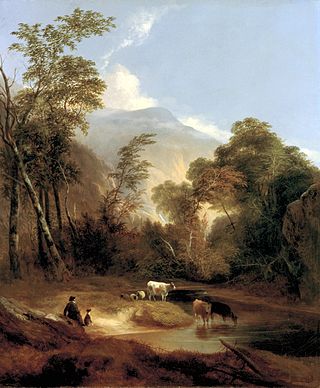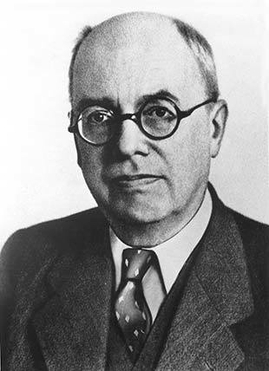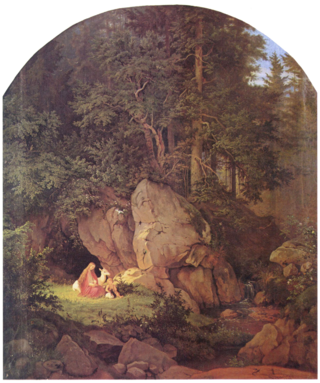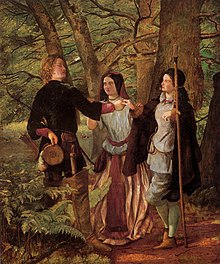
As a literary device or artistic form, an allegory is a narrative or visual representation in which a character, place, or event can be interpreted to represent a meaning with moral or political significance. Authors have used allegory throughout history in all forms of art to illustrate or convey complex ideas and concepts in ways that are comprehensible or striking to its viewers, readers, or listeners.

"Leaf by Niggle" is a short story written by J. R. R. Tolkien in 1938–39 and first published in the Dublin Review in January 1945. It was reprinted in Tolkien's book Tree and Leaf, and in several later collections. Contrary to Tolkien's claim that he despised allegory in any form, the story is an allegory of Tolkien's own creative process, and, to an extent, of his own life, following the structure of Dante's Purgatorio. It also expresses his philosophy of divine creation and human sub-creation. The story came to him in a dream.

Publius Vergilius Maro, usually called Virgil or Vergil in English, was an ancient Roman poet of the Augustan period. He composed three of the most famous poems in Latin literature: the Eclogues, the Georgics, and the epic Aeneid. A number of minor poems, collected in the Appendix Vergiliana, were attributed to him in ancient times, but modern scholars consider his authorship of these poems to be dubious.

A genre of arts criticism, literary criticism or literary studies is the study, evaluation, and interpretation of literature. Modern literary criticism is often influenced by literary theory, which is the philosophical analysis of literature's goals and methods. Although the two activities are closely related, literary critics are not always, and have not always been, theorists.

The Acheron is a river in the Epirus region of northwest Greece. It is 52 km (32 mi) long, and its drainage area is 705 km2 (272 sq mi). Its source is near the village Zotiko, in the southwestern part of the Ioannina regional unit. The Acheron flows into the Ionian Sea in Ammoudia, near Parga.
Herman Northrop Frye was a Canadian literary critic and literary theorist, considered one of the most influential of the 20th century.

Jacopo Sannazaro was an Italian poet, humanist, member and head of the Accademia Pontaniana from Naples.

The pastoral genre of literature, art, or music depicts an idealised form of the shepherd's lifestyle – herding livestock around open areas of land according to the seasons and the changing availability of water and pasture. The target audience is typically an urban one. A pastoral is a work of this genre. A piece of music in the genre is usually referred to as a pastorale.

In classical Greek rhetoric, topos, pl.topoi,, in Latin locus, refers to a method for developing arguments.

Anatomy of Criticism: Four Essays is a book by Canadian literary critic and theorist Northrop Frye that attempts to formulate an overall view of the scope, theory, principles, and techniques of literary criticism derived exclusively from literature. Frye consciously omits all specific and practical criticism, instead offering classically inspired theories of modes, symbols, myths and genres, in what he termed "an interconnected group of suggestions." The literary approach proposed by Frye in Anatomy was highly influential in the decades before deconstructivist criticism and other expressions of postmodernism came to prominence in American academia circa 1980s.

Arcadia refers to a vision of pastoralism and harmony with nature. The term is derived from the Greek province of the same name which dates to antiquity; the province's mountainous topography and sparse population of pastoralists later caused the word Arcadia to develop into a poetic byword for an idyllic vision of unspoiled wilderness. Arcadia is a poetic term associated with bountiful natural splendor and harmony. The 'Garden' is often inhabited by shepherds. The concept also figures in Renaissance mythology. Although commonly thought of as being in line with Utopian ideals, Arcadia differs from that tradition in that it is more often specifically regarded as unattainable. Furthermore, it is seen as a lost, Edenic form of life, contrasting to the progressive nature of Utopian desires.
Green World is a literary concept defined by the critic Northrop Frye in his book, Anatomy of Criticism (1957). Frye defines this term using Shakespeare's romantic comedies as the foundation. In Anatomy of Criticism, Frye describes the Green World as "the archetypal function of literature in visualizing the world of desire, not as an escape from "reality," but as the genuine form of the world that human life tries to imitate." The plots of these comedies often follow the formula of action starting in the normal world and then progressing to an alternate one in which the conflict is resolved before returning to the normal world. The plot of the Shakespearean romantic comedy is built upon the tradition established by the medieval "season ritual-play," the plots of which thematically deal with the triumph of love over the wasteland. The concept of the Green World is used to contrast the civilized world of man with the often harsh natural world.

Ernst Robert Curtius was a German literary scholar, philologist, and Romance languages literary critic, best known for his 1948 study Europäische Literatur und Lateinisches Mittelalter, translated in English as European Literature and the Latin Middle Ages.
Archetypal literary criticism is a type of analytical theory that interprets a text by focusing on recurring myths and archetypes in the narrative, symbols, images, and character types in literary works. As an acknowledged form of literary criticism, it dates back to 1934 when Classical scholar Maud Bodkin published Archetypal Patterns in Poetry.

Alazṓn is one of three stock characters in comedy of the theatre of ancient Greece. He is the opponent of the eirôn. The alazṓn is an impostor that sees himself as greater than he actually is. The senex iratus and the miles gloriosus are two types of alazṓn.
Allegory is used extensively in Renaissance literature. Developing from the use of allegory in the Middle Ages, Renaissance literature exhibits an increased emphasis on courtly love, sometimes abandoning intelligibility for deliberately unintelligible allegories.

In folklore and fantasy, an enchanted forest is a forest under, or containing, enchantments. Such forests are described in the oldest folklore from regions where forests are common, and occur throughout the centuries to modern works of fantasy. They represent places unknown to the characters, and situations of liminality and transformation. The forest can feature as a place of threatening danger, or one of refuge, or a chance at adventure.

Magic in fiction is the endowment of characters or objects in works of fiction or fantasy with powers that do not naturally occur in the real world.
Randel McCraw Helms, also known as Loyce Helms is an American professor of English literature, a writer on J. R. R. Tolkien and critical writer on the Bible.

The Pastoral Concert or Le Concert Champêtre is an oil painting of c. 1509 attributed to the Italian Renaissance master Titian. It was previously attributed to his fellow Venetian and contemporary Giorgione. It is located in the Musée du Louvre in Paris.



















